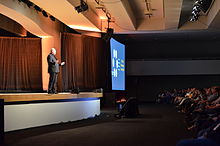Amazon Elastic Compute Cloud
EC2 provides users with control over the geographical location of instances that allows for latency optimization and high levels of redundancy.[3] Amazon announced a limited public beta test of EC2 on August 25, 2006,[4] offering access on a first-come, first-served basis.[7] Amazon added three new features on March 27, 2008,[8] static IP addresses, availability zones, and user selectable kernels.On August 20, 2008, Amazon added Elastic Block Store (EBS)[9] This provides persistent storage, a feature that had been lacking since the service was introduced.[12][13] Pinkham provided the initial architecture guidance for EC2 and then built the team and led the development of the project along with Willem van Biljon.[14] However, on November 6, 2017, Amazon announced[15] the new C5 family of instances that were based on a custom architecture around the KVM hypervisor, called Nitro.[35] Amazon EC2 Spot instances are spare compute capacity in the AWS cloud available at up to 90% discount compared to On-Demand prices.[23] As a trade-off, AWS offers no SLA on these instances and customers take the risk that it can be interrupted with only two minutes of notification when Amazon needs the capacity back.[42] When it launched in August 2006, the EC2 service offered Linux and later Sun Microsystems' OpenSolaris and Solaris Express Community Edition.[48][49][50] The FreeBSD/EC2 platform is maintained by Percival[51] who also developed the secure deduplicating Amazon S3-cloud based backup service Tarsnap.[9] EBS volumes provide persistent storage independent of the lifetime of the EC2 instance, and act much like hard drives on a real server.A user can programmatically map an elastic IP address to any virtual machine instance without a network administrator's help and without having to wait for DNS to propagate the binding.[57] CloudWatch does not provide any memory, disk space, or load average metrics without running additional software on the instance.[66] The schedule-based (e.g. time-of-the-day) and rule-based (e.g. CPU utilization thresholds) auto scaling mechanisms are easy to use and efficient for simple applications.[68] NOTE: the examples, figures and comparison charts in this section are from 2018 in the best case; please bear this in mind, as the situation has changed a lot from then.[70] EC2 provides users with control over the geographical location of instances that allows for latency optimization and high levels of redundancy.For example, to minimize downtime, a user can set up server instances in multiple zones that are insulated from each other for most causes of failure such that one backs up the other.In early July 2008, the anti-spam organizations Outblaze and Spamhaus.org began blocking Amazon's EC2 address pool due to problems with the distribution of spam and malware.[76] Shortly before 5 am ET on April 21, 2011, an outage started at EC2's Northern Virginia data center that brought down several websites, including Foursquare, Springpad, Reddit, Quora, and Hootsuite.Service was restored to some parts of the data center (three of four "availability zones" in Amazon's terms) by late afternoon Eastern time that day;[80] problems for at least some customers were continuing as of April 25.[84] The power outage raised multiple questions regarding Amazon's EBS infrastructure, which caused several bugs in their software to be exposed.[85] August 8, 2011, saw another network connectivity outage of Amazon's Northern Virginia data center, knocking out the likes of Reddit, Quora, Netflix and FourSquare.








Original author(s)Developer(s)AmazonOperating systemMicrosoft WindowsFreeBSDVirtual private serverLicenseProprietary softwarecloud-computingAmazon Web Servicesvirtual computersweb serviceAmazon Machine Imagevirtual machineserverlatencyredundancyTimeline of Amazon Web ServicesElastic Block StoreMicrosoft SQL Serverload balancingautoscalingCape Town, South AfricaWillem van BiljonKVM hypervisorreserve priceIsraeli Institute of TechnologySun MicrosystemsOpenSolarisSolaris Express Community EditionWindows Server 2003Windows Server 2008operating systemsNetBSDWindows Server 2012Colin PercivaldeduplicatingAmazon S3TarsnapFedoraRed Hat Enterprise LinuxAmazon Linux AMILinux kernelOpenJDKGNU Compiler CollectionmacOS MojavemacOS CatalinaMac MiniAmazon Elastic Block Storeblock devicesfilesystemmountingSimple Storage Service (S3)Apache HadoopMapReduceauto-scalingfault-tolerantAmazon Relational Database ServiceOutblazeSpamhaus.orgmalwareWikiLeaksAnonymousNorthern VirginiaFoursquareSpringpadRedditHootsuiteAmazon Virtual Private CloudAlibaba CloudAppScaleBitnamiCopperEggElasticHostsEucalyptus (software)FlexiScaleFUJITSU Cloud IaaS Trusted Public S5GoGridGoogle App EngineGoogle Cloud PlatformGreenQloudInternapLinodeLunacloudMicrosoft AzureNimbulaOpenShiftOracle CloudOrionVMOVHcloudRackspace CloudRightScaleSavvisTurnKey Linux Virtual Appliance LibraryZadaraThe RegisterYouTubeTechCrunchSchuster, AssafTypepadCloudHealth TechnologiesPC WorldKrebs, BrianThe Washington PostThe GuardianThe New York TimesJeff BezosAndy JassyWerner VogelsRick DalzellPaul DavisTony HsiehChristopher NorthRam ShriramTom SzkutakBrian ValentineList of Amazon locationsDopplerPrincipal PlaceSpheresBellevue 600A9.comAbeBooksAmazon ClinicAmazon Games